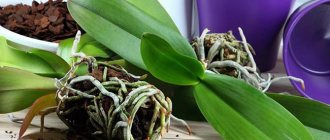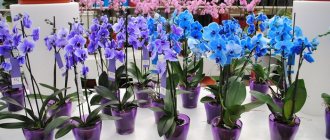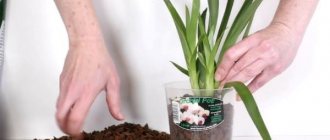The beautiful and delicate orchid gradually stops flowering, and the pot becomes noticeably cramped for it. To prevent problems with growing and wait for future flowering, you need to know how to replant an orchid at home. The editors of Agronom.guru will tell you in the article what pitfalls can await you during transplantation.
With proper care, the plant will delight you with beautiful flowering
Why you need to replant - the main reasons
The recommended schedule for replanting phalaenopsis into a new container or other substrate is every 2-3 years. This is due to the stress the plant experiences during this process.
Any variety of orchid needs timely replanting
The urgent need for a new pot or soil is due to the following factors:
- soil depletion;
- disturbance of the balance of mineral substances in the substrate;
- change in acidity level;
- loss of breathability;
- soil compaction does not allow the root system to develop optimally and even causes root rot;
- replanting after 3 years is necessary if the main component in the substrate was bark. If it was sphagnum moss, then the soil needs to be replaced within 2 years after planting.
A cramped pot, from which roots stick out in all directions, needs to be replaced with a more spacious one.
If the pot has become cramped, the roots will begin to push the soil out of the container, which will undoubtedly affect the health of the flower.
Is it possible to replant a flowering plant?
An emergency transplant during flowering can be done for a number of reasons: an army of pests has appeared on neighboring plants, you notice signs of rotting or other diseases. An orchid is also replanted after purchase, even during flowering, if it is obvious that the flower does not feel well in this soil. We will tell you how to do this below.
Sometimes you have to make a choice: a long life of a plant with delayed flowering or short days in bloom and the death of the orchid. If you want to see your plant healthy and pleasing to the eye for many years, then do not ask whether it is possible to replant the plant during flowering. It’s better to cut off the peduncle and replant the beauty.
What kind of pot is needed - capacity requirements
A pot for orchids must be transparent. This condition is necessary in order to observe the development of roots and monitor the condition of the soil. If desired, transparent containers are placed in a pot that is pleasing to the eye. We recommend choosing a larger pot. It will be enough if the new container is several centimeters wider than the previous one.
Before replanting, the new container is disinfected, and then only a layer of drainage is laid out.
How to choose a substrate and which soil is suitable
The beautiful orchid needs a loose substrate. It is preferable to purchase a ready-made mixture in a store. If you undertake to prepare the soil yourself, then take expanded clay for drainage, sphagnum moss or crushed conifer bark and charcoal.
The substrate should not only provide the flower with nutrition and oxygen, but also help secure the plant in the pot
After a couple of years, you will notice that the coal and bark have turned into dust, the soil has become dense and settled - it’s time to replant. To help you appreciate the benefits of breathable soil, we offer an introductory video on how to replant an orchid at home:
Features of dwarf species
Dwarf flowers attract attention not only with their small size, but also with their ease of maintenance (compared to ordinary tall species). Placing such indoor plants in your home will not take up much space, and if you choose the right variety, it will also delight you with long-lasting flowering.
The sizes of dwarf flowers can vary. The average length of the leaves is 15-20 cm. The color and shape of the petals are different. Flowering often occurs in winter, but there are also varieties with two periods of bud formation.
Most of the compact flowers grow on sphagnum moss soil. The presence of tree bark is also allowed. Such plants are demanding on the composition of the substrate and do not like change. In order for a flower to continue to delight its owner with its beauty, it is important to provide it with the most comfortable conditions possible.
When to act immediately
If you notice that the soil has become dense, all the large components are more like dust, the orchid has become a refuge for aphids, thrips, scale insects and other “cute” guests, then it won’t be long until the plant dies completely. Sometimes you can notice rotting of the roots, or the green mass of leaves has become much larger than the size of the pot, which means you need to urgently replant the orchid, and we will tell you how to do this correctly at home.
If your orchid has just arrived at its new location from the store and looks completely healthy, replanting is not required. But when your ward looks unwell after purchase, it is better to start replanting it immediately.
How to get rid of midges in indoor flowers using simple methods. In a special publication on our portal, we will talk in detail about how to get rid of pests in indoor plants. You will learn the reasons for their appearance, the types of midges and their signs and measures to prevent the appearance of midges.
What you definitely need to know
Phalaenopsis belongs to the category of monopodial orchids.
This means that they have a root system, a trunk and leaves hugging it. This type of orchid has one growth point; if it dies, the plant can grow a baby. There are meristem buds on the trunk: some are responsible for the growth of roots, others for flower stalks, and from others, stepchildren develop. Children grow up on Phalaenopsis extremely rarely. But there are varieties that grow them constantly, without forgetting to bloom.
In nature, Phalaenopsis grow on tree branches, but are not parasites. They hold onto the tree with their roots, absorbing moisture from the surrounding space. They can be grown on blocks or in a substrate consisting of pine bark, coal, peat or sphagnum moss. The soil must be well breathable and sufficiently moisture-absorbing.
Quarantine
Although Phalaenopsis sold in stores undergo phytocontrol, nevertheless, insects and diseases very often enter the house with them. Having brought an orchid from the store, it must be placed separately from other flowers until it is treated against pests and possible diseases.
The purchased Phalaenopsis should be left alone for several days - let it adapt. You shouldn’t water it either; the store has already taken care of this. Despite the apparent dryness of the substrate, there is still enough moisture inside, since the supplied flowers sit either in a dense coma of sphagnum moss or in the bark, but the bottom of the trunk or “butt” is placed in a cup of peat or the same moss. Both substances dry out extremely slowly.
Preparation
The more responsibly you approach the transplant, the more successful the process itself will be. Before you get started, prepare everything you need: disinfected scissors or a sharp knife for cutting faded peduncles, a new transparent pot, fresh loose substrate, an activated carbon tablet.
If the orchid has just finished delighting you with its flowering, then the peduncle needs to be cut off. After this, you can begin the process of replanting the plant.
Step by step guide
To make the process of transplanting an orchid at home easy, we suggest studying all the key points step by step.
We remove the flower from the previous pot. The more careful the better. The root system must remain intact
For trouble-free removal, it is recommended to knead the pot with your hands.
If the soil or pot is too dense and the plant does not give in, then it is better to sacrifice the container rather than the flower and cut it with scissors. Since the process can be messy, we recommend laying out a large newspaper or heading to the bathroom.
It is generally preferable to remove a plant from a pot under running water, so the roots can be removed painlessly and immediately inspected for pests or rot
Now we will tell you how to properly plant an orchid in a pot. Expanded clay is placed in a new container and lightly sprinkled with substrate. Then you need to carefully plant the orchid, spreading the roots evenly. Hold the plant by the root collar. The remaining space is filled with substrate, the pot is tapped and the plant is watered.
The upper aerial roots should not be forced into the pot; leave them on the surface of the soil.
When examining the roots during transplantation, rotting processes or parasites can be detected. Diseased parts of the roots are cut off and thrown away, the sections are treated with Kornevin and sprinkled with charcoal. The same applies to dried roots. If you notice pests, the plant must be placed in a container with warm, clean water for 2-3 hours, and then treated with a suitable insecticide.
Planting into new soil after washing the roots is carried out only after the root system has completely dried
The lower yellowed leaves of the plant are also removed.
Now you know how to painlessly transplant an orchid into another pot
Transfer rules
First you need to find a larger container. It must have a drainage hole and a tray to drain excess moisture. The prepared container is filled with a special substrate. You can buy it at a flower shop.
The soil mixture is selected depending on the type of crop. Orchids, or epiphytes, growing on trees require a combination of moss and charcoal. Expanded clay can be used as drainage. Foam plastic, which loosens the substrate, is of great benefit. But large amounts of this material are undesirable because it releases harmful compounds. Terrestrial orchids prefer peat with humus or vermiculite, which compacts the soil mixture and disinfects it.
The plant is carefully removed from the container along with the roots, clasping it with both hands. First, the flower is placed in a basin of water and allowed to settle for a bit. After an hour, the roots are washed, dried, and damaged parts are removed with pruning shears. To prevent fungal diseases, they can be treated with fungicides or antiseptics.
Related article:
Garlic - salvation for orchids
A new pot for disinfection is doused with boiling water. You can do the same with the substrate to get rid of diseases and pests. The culture is replanted after 8 hours of drying. The roots are carefully placed in a new container and sprinkled with substrate on top. In order for the plant to develop normally, the rosette is left outside.
The transplanted orchid is left in a darkened room for 5-10 days. If you immediately leave the crop in direct sunlight, it will become severely stressed. Within a week, the plant will adapt to new conditions and can be moved to a lighted place.
Interesting! How to care for an orchid
Post-procedure care
The period after transplantation is called recovery for a reason. Any major intervention in the life of a plant creates stress for it. So, a few rules on what to do after transplantation:
- the pot is placed in a shaded place, closer to the eastern window;
- air temperature is maintained within +21°C;
- watering after transplantation is done after 5 days;
- leaves can be sprayed daily with warm water;
- after a month they begin to apply fertilizers.
Simple care techniques will allow this beautiful flower to quickly gain strength.
Consequences and best time in spring
Phalaenopsis are the easiest to adapt after transplantation during the flowering period. They practically do not suffer - they continue to flower and quickly take root.
Other, more demanding varieties may suffer for a long time or even die.
For them, it is better to carry out the procedure in late February - early March, after the dormant period ends and before active growth begins.
What problems may arise
Let's consider possible problems that may appear after transplantation.
- If the leaves look lethargic, it means you are being greedy with watering: the substrate should not dry out completely. Another reason may be exposure to direct sunlight. Try putting the plant in the shade for a week.
- The plant does not bloom for a long time: if the establishment process is delayed, start feeding earlier.
The more carefully and accurately the transplantation process is completed, the less chance there will be problems after it.
Reproduction at home
The royal flower is the orchid. Care and reproduction at home. In a special publication on our portal, we will talk in detail about how to care for and propagate an orchid at home. You will learn how to properly water an orchid, the nuances of caring for different varieties of orchids, and how to make an orchid bloom at home.
If your plant is mature and you know how to plant an orchid at home, you can start propagating it by getting several flowers at once.
If you have an unusual variety, share it with friends or exchange it with others. This is common on flower forums and is a great chance to add to your collection.
Despite the known four methods of reproduction, two are usually used at home: by children and by dividing roots. After the orchid has bloomed, you can find children from it - side shoots. They are planted in a new small container, maintaining high temperature and humidity in the room.
After some time, the babies take root and turn into an ordinary orchid.
The plant is propagated by dividing the roots, provided that the bulb grows well. It is cut in half, treated with charcoal and planted in different pots. Whatever method you choose, you will need to maintain high temperature and optimal air humidity around the indoor plant for some time.
We can say that the orchid is an amazing plant, and you should not be afraid of the difficulties in growing it. If you want to learn more about how to replant an orchid at home, in addition we offer another educational video where you will hear a lot of tips:
Varieties of dwarf plants
Having decided to buy yourself a dwarf exotic plant, you should decide on the best variety for growing in certain conditions. Types of mini orchids are varied:
- Phalaenopsis;
- Cymbidium;
- Cattleya;
- Oncidium.
Each gardener independently chooses a suitable flower for himself, both according to external features and other criteria. These species include dozens of varieties, distinguished by their own decorative properties and demanding care.
Phalaenopsis
The peculiarity of phalaenopsis is the abundance and duration of flowering. It is also important that such flowers rarely enter a dormant period, which is also appreciated by gardeners. The most popular varieties are:
- Orchid Mini Mark. Variety Mark is distinguished by double flowering. The length of the leaves is up to 14 cm, the diameter of the flowers is 4 cm. The petals are white or cream, with pink or orange splashes.
- Dendrobium. This variety is distinguished by its abundance of flowering. Up to 35 flowers appear on a peduncle. The color is white or purple.
- Lüdemann variety. It is distinguished by the disproportionate shape of the petals and sepals. The color is pink-violet, darker at the base of the petals. There are dark spots on the “lip”. The height of the leaves does not exceed 20 cm, the diameter of the blossoms is 5 cm. Up to 7 pieces appear on one peduncle.
- Mini Dog. Has compact dimensions. The length of the leaves does not exceed 15 cm, the diameter of the flowers is 3-4 cm. The color is white with a pink tint, the “lip” is burgundy, and some petals may have a yellow tint.
When choosing a Phalaenopsis variety, it is important to take into account the characteristics of their content. Caring for such a flower is necessary all year round, as it rarely goes into a dormant period.
Cymbidium
If the main goal is to purchase a low-maintenance flower, the best option would be the Cymbidium species. Subspecies of such plants are distinguished by a pleasant aroma and have a beautiful appearance.
The most popular is the aloe-leaved subspecies of the crop. This plant will fit compactly on any windowsill. The height of the stem does not exceed 25 cm, and the flowering is 5 cm in diameter. The color of the petals is yellow. Burgundy shades may also predominate.
Cattleya
This species is distinguished by a variety of varieties with buds of different colors (from white to purple). The height of such a plant reaches 20 cm. The most famous varieties are Walker, Atlanda and Skinner.
Plant height is only 20 centimeters
The Walker variety has gained the most popularity. It is distinguished by the relative proportionality of the height of the stem and the size of the blooms. The average leaf size is 10 cm, and the flowers themselves can reach 8 cm in diameter.











